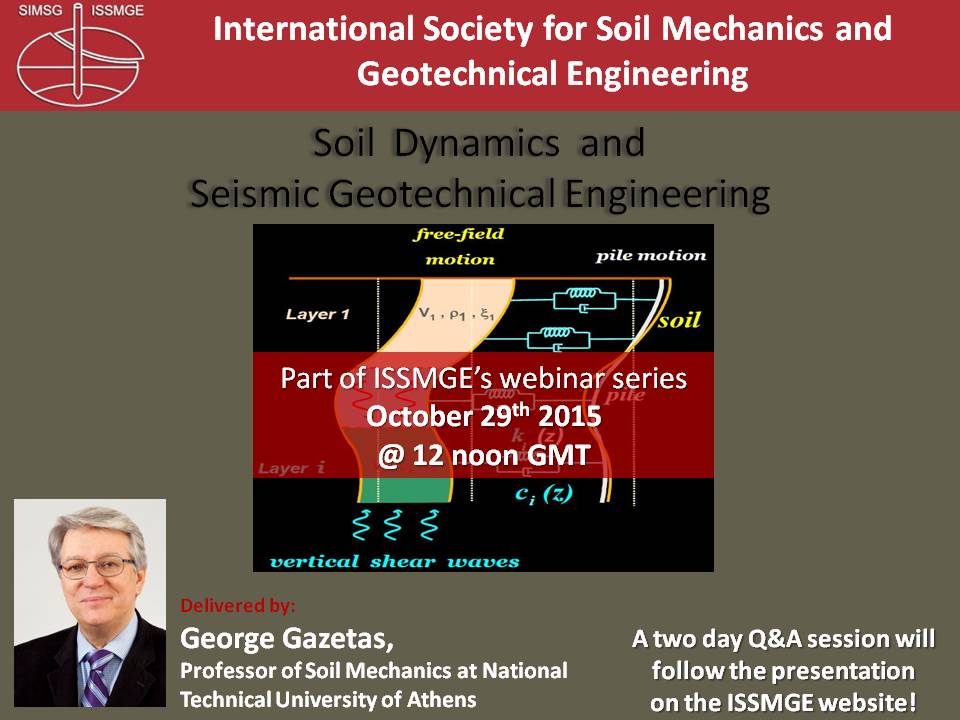![Cyclic soil parameters for offshore foundation design (Third ISSMGE McClelland Lecture) {"category":"honour_lecture","subjects":["Soil Dynamics", "Offshore Geotechnics"],"number":"HML103","instructors":["Knut H. Andersen"]}](/asset-v1:ISSMGE+HML103+2015+type@asset+block@hml103.jpg)
- ISSMGE
- {"category":"honour_lecture","subjects":["Soil Dynamics", "Offshore Geotechnics"],"number":"HML103","instructors":["Knut H. Andersen"]}
- Starts:

This course includes three lectures, by Ikuo Towhata (Japan), George Gazetas (Greece) and Misco Cubrinovski (New Zealand). The titles and the summaries are as follows:
Earthquake geotechnical engineering-mitigation of earthquake problems with emphasis on subsoil liquefaction, by Ikuo Towhata (130min)
First, some features of earthquakes induced geotechnical damages are introduced. In this frame, an introduction to subsoil liquefaction was made. Then, its causative mechanism was highlighted. Further, its induced ground deformation and mitigation were reviewed. Second, some of the encountered issues during recent earthquakes in Japan and New Zealand were highlighted
Soil Dynamics and seismic geotechnical Engineering, by George Gazetas (106min)
The earthquake source and related term magnitude are first exposed. Consequence of fault rupture on the surface was highlighted from lived seism in Taiwan and China. Soil amplification was pointed out through Mexico‘s earthquake in 1985. Two case histories from Japan were investigated to discuss the soil-structure interaction. An application to slope and retaining walls using sliding and rocking of rigid block failure mechanisms.
Impacts of liquefaction in the 2010-2011 Christchurch Earthquakes, by Misco Cubrinovski (83min)
The Canterbury earthquake was first characterized followed by the induced Christchurch liquefaction. This last impact on buildings and infrastructure were discussed after making an overview on lateral spreading in post liquefaction stage.
![Cyclic soil parameters for offshore foundation design (Third ISSMGE McClelland Lecture) {"category":"honour_lecture","subjects":["Soil Dynamics", "Offshore Geotechnics"],"number":"HML103","instructors":["Knut H. Andersen"]}](/asset-v1:ISSMGE+HML103+2015+type@asset+block@hml103.jpg)
![Simplified Procedure for Estimating Liquefaction - Induced Buildling Settlements (Ishihara Lecture - 19th ICSMGE) {"category":"honour_lecture","subjects":["Liquefaction Engineering"],"number":"ICSMGE19110","instructors":["Jonathan D Bray"]}](/asset-v1:ISSMGE+ICSMGE19110+2017+type@asset+block@ishihara-lecture.jpg)
![Geo-Characterization Using Waves - Principles to Application (Host Society Special Lecture - 19th ICSMGE) {"category":"honour_lecture","subjects":["Soil Dynamics"],"number":"ICSMGE19117","instructors":["Jong-Sub Lee"]}](/asset-v1:ISSMGE+ICSMGE19117+2017+type@asset+block@host-lecture.jpg)
![In-Situ Testing {"category":"course","subjects":["In-situ Testing","CPT","Geophysics","Seismic Geophysics","Soil Dynamics"],"number":"VU-GE","instructors":["Sebastiano Foti","Fernando Schnaid","Peter Robertson","Kenneth H. Stokoe"]}](/asset-v1:ISSMGE+TC102-001+2017+type@asset+block@cone-penetration-testing.png)
![Third Victor de Mello Lecture: Role of Geophysical Testing in Geotechnical Site Characterization {"category":"honour_lecture","subjects":["Geophysics","In-situ Testing","Soil Dynamics"],"number":"VDM3","instructors":["Michele Jamiolkowski"]}](/asset-v1:ISSMGE+VDM3+2018+type@asset+block@Third-Victor-de_Mello-Lecture.png)